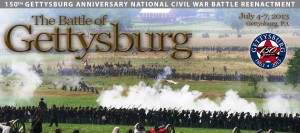Pickett’s Charge

“The High Water Mark” – Pickett’s Charge
“Pickett’s Charge” Just the mention of those two words brings forth a flood of visual and sensory perceptions. Steaming humidity, ripe rye fields, lush green pastures, thundering cannon, suffocating smoke and row upon row of Confederate soldiers advancing across open fields into the face of a Federal inferno on Cemetery Ridge.
At precisely 1:07 p.m. – a field piece from the Washington Artillery, posted near the Peach Orchard, opened up the greatest cannonade in the annals of American history. It was a signal for the entire Confederate artillery line to let loose their terrific blast. It was a volcanic eruption for almost two hours with Confederate artillery pounding the Federal position on Cemetery Ridge in an attempt to soften the Federal center for the pending frontal assault. Correspondent Samuel Wilkenson of the New York Times, was at Meade’s headquarter and reported, “the Confederate shells burst and screamed as many as six a second and made a very hell of a fire that amazed the older officers – men were cut in two and horses died still fastened by their halters.” It is difficult to even comprehend 140 Confederate guns and 100 Federal guns belching fire, smoke, destruction and death.
Approximately two hours later Colonel Porter Alexander observed from his position near the Peach Orchard that the Federal guns had slackened fire and his own supply of ammunition was running low. He sent word to Pickett who in turn rode over to Longstreet, who had persistently opposed Lee’s plan. Longstreet merely nodded approval and Picket saluted saying “ I am going to move forward, sir.” With those words spoken, the Confederate infantry, three divisions totaling 12,000 men, majestically advanced from the woods on Seminary Ridge, across the open valley toward 6,000 troops on Cemetery Ridge. Because General Hunt had earlier ordered a partial cessation of Federal guns, to cool them and conserve ammunition, the Confederates were received by a fearful hurricane of missiles that included solid shot, shrapnel, spherical-case, shell, canister and every other invention of warfare at the time.
At a terrible cost in human life, the Federal line was broken at the “Copse of Trees” when determined Confederate forces crashed into Union troops at the Angle and forced them back over the ridge. For a moment of high suspense, victory hung trembling in the balance. Union troops under Webb, Harrow, Hays, and Stannard swiftly rose to the challenge and repulsed the Confederate assault to the heart of the Union. The Battle of Gettysburg was over. “The Copse of Trees” or “The Angle” unquestionably became the symbolic High Tide of the Confederacy.
Very seldom do you have this once in a lifetime opportunity to experience such an artillery barrage and vast number of troops reenacting one of the most famous battles in the history of the world. Your experience will be enhanced with extensive pyrotechnics and the burning of the Bliss Barn. Don’t miss this lifetime memory during The High Water Mark – Pickett’s Charge on Sunday, July 7, 3:30 p.m. at the 150th Gettysburg Anniversary National Civil War Battle Reenactment.
http://www.gettysburgreenactment.com/reenactors/battle-scenarios/


